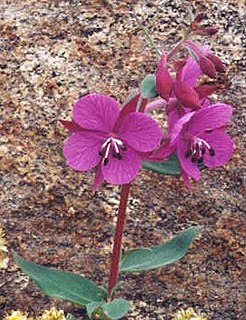This page provides a glossary of plant morphology. Botanists and other biologists who study plant morphology use a number of different terms to classify and identify plant organs and parts that can be observed using no more than a handheld magnifying lens. This page provides help in understanding the numerous other pages describing plants by their various taxa. The accompanying page—Plant morphology—provides an overview of the science of the external form of plants. There is also an alphabetical list: Glossary of botanical terms. In contrast, this page deals with botanical terms in a systematic manner, with some illustrations, and organized by plant anatomy and function in plant physiology.

Dudleya pulverulenta is a succulent plant known by the common names chalk lettuce, chalk dudleya, and chalk liveforever.

Gilia sinuata is a species of flowering plant in the phlox family known by the common names rosy gilia and rosy phlox. It is native to western North America from British Columbia to New Mexico, where it can be found in a number of open habitats, generally in sandy soil, and at elevations from 500 to 7500 feet.
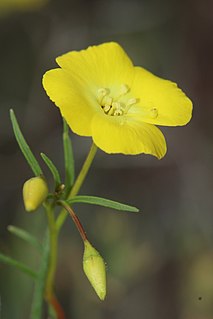
Eulobus californicus, is a species of flowering plant in the evening primrose family known by the common name California suncup. It is native to California, Arizona, and adjacent northwestern Mexico, where it grows in scrub, chaparral, and desert plant communities.
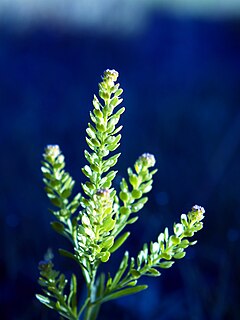
Lepidium densiflorum is a species of flowering plant in the mustard family known by the common names common pepperweed and prairie peppergrass.

Antirrhinum coulterianum is a species of New World snapdragon known by the common name Coulter's snapdragon.
Camissoniopsis intermedia is a species of evening primrose known by the common name intermediate suncup. It is native to California and Baja California, where it grows on the slopes of coastal and inland hills and mountains, especially in areas that have recently burned. It is an annual herb producing an erect, hairy stem up to about half a meter in height. Most of the leaves are located in a basal rosette at ground level and are oval to lance-shaped and up to 12 centimeters in length. The hairy, nodding inflorescence produces flowers with yellow petals just a few millimeters in length. The petals have one or two red dots at their bases. The fruit is a straight or coiling, wormlike capsule up to 2.5 centimeters long.

Camissonia parvula is a species of evening primrose known by the common name Lewis River suncup. It is native to the Great Basin of the United States. It grows in sagebrush, woodland, and other Great Basin habitat. It is a slender annual herb producing a wiry erect stem 15 to 30 centimeters in maximum height. The leaves are linear in shape and 1 to 3 centimeters long. They are located along the stem as there is no basal rosette. The nodding inflorescence produces flowers with yellow petals only 2 or 3 millimeters long. The fruit is a capsule 2 to 3 centimeters long, swollen with seeds, and sometimes coiling.

Cardamine pensylvanica is a species of Cardamine known by the common name Pennsylvania bittercress. It is native to most of Canada and the United States from coast to coast. It is generally found in moist to wet areas, such as the mud on riverbanks. It is a biennial herb producing one or more erect or leaning, branching stems which are purple to green in color and grow 10–70 cm (4–28 in) tall. The leaves are hairless and divided into several rounded to oval lobes, each of which has one or two lobes, with the exception of the large terminal leaflet at the tip, which generally has three. Most of the leaves are located along the stem and there is no basal rosette. The inflorescence comprises many flowers, each with four white petals a few millimeters long, blossoming from April to October. The fruit is a slender silique 2–3 cm (0.8–1.2 in) long.
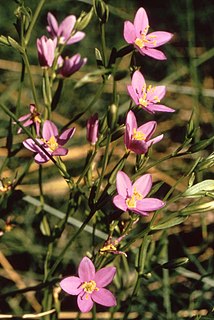
Centaurium calycosum is a species of flowering plant in the gentian family known by the common name Arizona centaury. It is native to northern Mexico and the southwestern United States, where it grows in moist places in otherwise dry habitat, such as riverbanks. This is an erect biennial herb growing up to half a meter tall. The widely lance-shaped leaves appear in a basal rosette and along the slender stem, each up to 7 centimeters long. The inflorescence is an open array of flowers on short pedicels. Each flower opens into five pointed lobes, each about a centimeter long and dark rose pink in color.
Gilia clokeyi is a species of flowering plant in the phlox family known by the common name Clokey's gilia. It is native to the southwestern United States from California to Colorado, where it grows in desert and other habitat.
Boechera constancei is a species of flowering plant in the mustard family known by the common name Constance's rockcress. It is endemic to California, where it is known only from the northern Sierra Nevada of Plumas and Sierra Counties. It is a member of the serpentine soils flora. This is a perennial herb growing from a branching, woody caudex. It produces one or more erect, hairless stems to maximum heights between 15 and 30 centimeters. The caudex is surrounded by a dense basal rosette of stiff, blue-green, lance-shaped leaves up to 3 centimeters long. There may be a few smaller leaves along the stem. The inflorescence produces 5 to 10 white mustardlike flowers with protruding stamens. The fruit is a hanging green silique 4 or 5 centimeters long which contains round, winged seeds.

Lewisia cantelovii is an uncommon species of flowering plant in the Montiaceae family known by the common name Cantelow's lewisia. It is endemic to California, where it is known from the northeastern mountain ranges from the Klamath Mountains to the northern Sierra Nevada. It grows in rocky, moist mountain habitat. This is a perennial herb growing from a short, thick taproot and caudex unit. It produces a basal rosette of thick, fleshy, blunt-tipped spoon-shaped leaves with serrated edges. The inflorescence is a very slender erect stem up to 45 centimeters tall topped with a spreading panicle of flowers and glandular, toothed bracts. Each flower has 5 to 7 oval petals each one half to one centimeter long. The petals are white or very pale pink with sharp dark pink veins. At the center of the flower are five stamens tipped with dark pink anthers.

Lewisia disepala is a species of flowering plant in the Montiaceae family known by the common name Yosemite lewisia.

Lewisia oppositifolia is a rare species of flowering plant in the Montiaceae family known by the common name opposite-leaf lewisia. It is native to the Klamath Mountains of Josephine County, Oregon, and Del Norte County, California, where it is a local serpentine endemic generally found in moist areas. This is a perennial herb growing from a small taproot and caudex unit. It produces a basal rosette of several lance-shaped, blunt-tipped fleshy leaves up to 11 centimeters long. There are sometimes smaller leaves located on the lower stem. The inflorescence is made up of one or more erect stems up to about 20 centimeters long, each bearing 1 to 6 flowers. The flower has 8 to 11 white to pale pink petals with blunt or jagged tips, each between 1 and 2 centimeters long. At the center are several stamens with pale anthers. This plant has a limited distribution and it is threatened by human activity in the area, such as logging.
Mentzelia eremophila is an uncommon species of flowering plant in the family Loasaceae known by the common names pinyon blazingstar and solitary blazingstar.
Sedum radiatum is a species of flowering plant in the stonecrop family known by the common name Coast Range stonecrop. It is native to Oregon and California, where it is known from several coastal and inland mountain ranges, including the Klamath Mountains and the Sierra Nevada. It grows in many types of rocky habitat, sometimes on serpentine soils. It is an annual or biennial succulent plant producing several stems with elevated, somewhat basal rosettes of leaves. The leaves are not much more than a centimeter long. They are green or yellowish with green, purple or red veining. The inflorescence is a short, erect array of many densely packed flowers. The flowers have yellow, cream, or white petals which are lance-shaped and one half to 1 centimeter long.
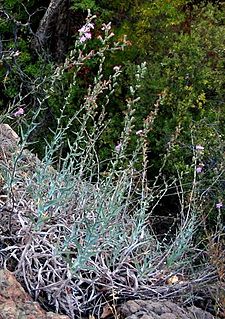
Stephanomeria cichoriacea is a species of flowering plant in the aster family known by the common names chicoryleaf wirelettuce and silver rock-lettuce. It is endemic to California, where it grows in the coastal mountain ranges as far north as Monterey County, but especially in southern California mountains such as the Transverse Ranges. Its habitat includes chaparral. It is a perennial herb producing slender erect stems reaching maximum heights exceeding one meter. The stem is woolly with hairs, especially on new growth. The leaves are mostly located in a basal rosette, the largest reaching 18 to 20 centimeters long. They are lance-shaped and often toothed along the edges, and the newer ones are woolly. Smaller leaves occur farther up the stem. The inflorescence is a long array of several flower heads, with some occurring in the upper leaf axils as well. Each head has a cylindrical base 1 to 2 centimeters long which is lined with layers of glandular phyllaries. The head contains 10 to 15 ray florets, each with an elongated tube and a pink ligule which may be up to 2 centimeters long. The fruit is an achene tipped with a spreading cluster of long, plumelike pappus bristles.
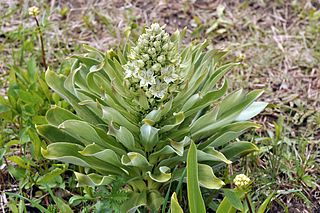
Frasera speciosa is a species of flowering plant in the gentian family (Gentianaceae) known by the common names elkweed, deer's ears, and monument plant.
Catananche lutea, is a woolly annual plant, assigned to the daisy family, with most leaves in a basal rosette, and some smaller leaves on the stems at the base of the branches. Seated horizontal flowerheads develop early on under the rosette leaves. Later, not or sparingly branching erect stems grow to 8–40 cm high, carrying solitary flowerheads at their tips with a papery involucre whitish to beige, reaching beyond the yellow ligulate florets. Flowers are present between April and June. This plant is unique for the five different types of seed it develops, few larger seeds from the basal flowerheads, which remain in the soil, and smaller seeds from the flowerheads above ground that may be spread by the wind or remain in the flowerhead when it breaks from the dead plant. This phenomenon is known as amphicarpy. The seeds germinate immediately, but in one type, germination is postponed. It naturally occurs around the Mediterranean. Sources in English sometimes refer to this species as yellow succory.

